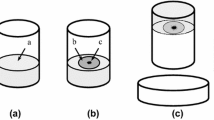Abstract
Investigations were conducted in the greenhouse to evaluate the biological performance of Aphis fabae Scopoli when bred on two varieties of the common bean, Phaseolus vulgaris L. Mean developmental period of the aphid was 7.8 days at 26.5°C (range 15.0–32.5°C) on the bean varieties Mwezi Moja (GLP. 10) and Red Haricot (GLP.3). The reproductive life of the aphid averaged 15.3 days (range 11–17 days) during which each mother aphid produced on average 55.2 and 56.2 nymphs on the two bean varieties, respectively. Nymphs (66.2%) were born during the daytime (0600–1800 hr), whereas only 33.8% of the nymphs were produced during the night (1800–0600 hr). There were two peaks of diurnal nymphal production, and more nymphs were born during the morning peak (0600–0800 hr) than during the mid-afternoon peak (1400–1600 hr). A very high rate of A. fabae population increase was observed.
Résumé
Des études sur l’évaluation des performances biologiques du puceron Aphis fabae Scopoli, élevé sur deux variétés de haricot Phaseolus vulgaris L. ètaient mévées en serre. La durée moyenne de la période de development était de 7, 8 jours á 26,5°C (variant de 15,0–32,5°C) sur les variétés Mwezi Moja (GLP-10) et Red Haricot (GLP 3). La phase reproductrice était d’une moyenne de 15,3 jours (variant de 11–17 jours), durant laquelle chanque femelle avait engendrée une moyenne de 55,2 et 56,2 nymphes sur GLP 10 et GLP 3 respectivement. Une majorité de 66,2% de nymphes était ne le jour pendantque 33.8% seulement l’était durant la nuit. Il y avait deux pics sur la courbe de la production nymphale diurne et plus de naissances étaient enregistrées au cours du pic matinal (0600–0800 hr) que pendant celui de l’après-midi (1400–1600 hr). Un aux d’accroissement très élevé de la population du puceron A. fabae a été observé.
Similar content being viewed by others
References
Davidson J. and Fisher R. A. (1922) Biological studies of Aphis rumicis Linn. Reproduction on varieties of Vicia faba. Ann. appi. Biol. 9, 135–145.
Duncan D. B. (1955) Multiple range and multiple F tests. Biometrics 11, 1–42.
Eastop V. F. (1953) A study of the Aphididae (Homoptera) of East Africa. Colon. Res. Pubi. No. 20, London, Colonial Office, H.M.S.O.
Eastop V. F. (1957) The periodicity of aphid flight in East Africa. Bull. ent. Res. 48, 305–310.
Emden H. F. van (1972) Aphid Technology, 1st edn. Academic Press, London.
Ingram W. R. (1969) A note on the failure to control aphid infestations on beans with insecticides in Uganda. E. Afr. agrie. For. J. 34, 476–481.
Johnson C. G., Haine E., Cockbain A. J. and Taylor L. R. (1957) Moulting rhythm in the alienicolae of Aphis fabae Scop. (Homoptera: Aphididae) in the field. Ann. appi. Biol. 45, 702–708.
Kennedy J. S. and Booth C. O. (1950) Methods for mass rearing and investigating the host relations of Aphis fabae Scop. Ann. appi. Biol. 37, 451–470.
Kennedy J. S. and Stroyan H. L. G. (1959) Biology of aphids. A. Rev. Ent. 4, 139–160.
Lees A. D. (1959) The role of photoperiod and temperature in the determination of parthenogenetic and sexual forms in the aphid Megoura viciae Buckton—I. The influence of these factors on apterous virginoparae and their progeny. J. Insect Physiol. 3, 92–117.
Taylor L. R. (1957) Temperature relation of teneral development and behaviour in Aphis fabae Scop. J. exp. Biol. 34, 189–208.
Author information
Authors and Affiliations
Rights and permissions
About this article
Cite this article
Ogenga-Latigo, M.W., Khaemba, B.M. Some Aspects of the Biology of the Black Bean Aphid Aphis Fabae Scopoli Reared on the Common Bean Phaseolus Vulgaris L.. Int J Trop Insect Sci 6, 591–593 (1985). https://doi.org/10.1017/S1742758400009152
Received:
Revised:
Published:
Issue Date:
DOI: https://doi.org/10.1017/S1742758400009152




